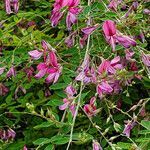Shrubs, subshrubs, or perennial herbs, erect, 1-3 m tall, much branched, pilose. Leaves 3-foliolate; petiole 1-5 cm, pubescent; leaflets elliptic, oblong-elliptic, or ovate, rarely terminal one obovate, terminal one 2.5-6 × 1-3 cm, abaxially adpressed pubescent, adaxially puberulent or glabrescent, rarely glabrous, both ends slightly acute or obtuse. Racemes simple, axillary, longer than leaves, or branched in panicles, terminal; peduncle to 10 cm, pubescent. Pedicel short, hairy. Calyx 4-7 mm, 5-lobed; lobes oblong-lanceolate, 1-4 × as long as tube. Corolla reddish purple or more rarely white, 1-1.5 cm; standard nearly orbicular or slightly long, auriculate, clawed; wings obovate-oblong, 7-8 mm, auriculate, clawed; keel longer than or equal to standard, distinctly longer than wings, auriculate, clawed. Legume obovoid or obovoid-oblong, ca. 8 × 4 mm, pilose, reticulate veined. Fl. Jul-Sep, fr. Sep-Oct. 2n = 40*.
More
Shrub or half-shrub 1–3 m; stipules slender but persistent; lfls elliptic or lance-elliptic, 1–4 cm, glabrous above, paler and strigose beneath; fls showy, purple, 12–17 mm, borne in numerous lax, axillary racemes; cal-lobes slender, long-pointed, evidently longer than the tube, the 2 upper connate most of their length; 2n=22. Native of China and Japan, rarely escaped from cult. in our range. Sept., Oct.
A herb or small shrub. It keeps growing from year to year. It grows 1-3 m tall. The leaves have 3 leaflets. They are oblong and the end one is 3-6 cm long by 1-3 cm wide.
Mountain slopes, forest margins, roadsides and thickets; at elevations up to 2,800 metres.
Can be grown by cuttings, divisions or seedlings. Seeds needs soaking.


